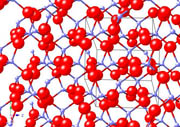The Chemical Bond
The chemical bond attracts atoms together to form molecules of new substances or ionic solids. It is interesting to know how to build new substances from the existing ones, or directly from the atoms, so that we can make substances that are useful. Al chemistry is based on the idea of the chemical bond. The electrons play the prominent role in that, so it is not surprising that we hear of them all the time. Energies, orbitals, shells, subshells, quantum numbers… All these concepts are studied in chemistry, and more… So, how is that atoms stick together to form new substances? There are 2 types of chemical bonds: 2) Ionic bonds 
An understanding of how molecules form is also crucial for many industries and business. The pharmaceutical industry, the food industry, biology, medicine, engineering, petrochemicals and many others… .All this industries need to produce new substances with the chosen properties.
Making a chemical bond to form a molecule is a process that transfers energy and the branch of chemistry that deals with the energetics of chemical reactions is called chemical thermodynamics, to differ from "ordinary" thermodynamics which belongs to physics. It is part of physical chemistry. Learn more

